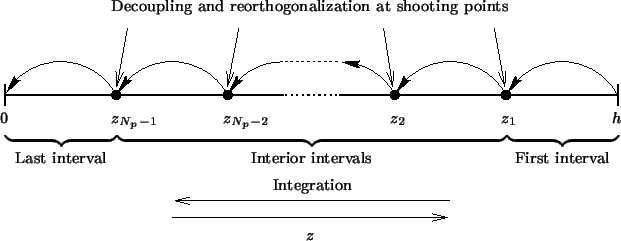
|
We will only outline the principle of multiple shooting employing
reorthogonalization and decoupling. Additionally, compactification is
applied--a technique that leads to formulae that can be evaluated recursively.
The storage demands of the algorithm are thus not increased in comparison
to the previous ones and the performance with respect to stability is not
degraded due to the separated BCs.g
Both properties are of utmost importance for our application.
The description of this so-called stabilized march algorithm is divided
into three
different parts since the first and last sub-interval have to be treated
individually.
A graphical illustration of the algorithm, especially the integration direction
and the multiple shooting technique, is shown in Figure 6.4.

|
First interval
(p = 1).
In the first interval
z ![]() [z1, h] we carry out Step 1 and Step 2 of the
shooting algorithm using reduced superposition
(cf. Table 6.3), i.e., we perform a QR-factorization
of the boundary matrix
[z1, h] we carry out Step 1 and Step 2 of the
shooting algorithm using reduced superposition
(cf. Table 6.3), i.e., we perform a QR-factorization
of the boundary matrix
![]() to determine the initial
values
to determine the initial
values
![]() (h) =
(h) = ![]() at the first
starting point z0 = h, and integrated then the IVP
at the first
starting point z0 = h, and integrated then the IVP
| (6.46) |
Interior intervals
(p = 2,..., Np - 1).
For the interior intervals
z ![]() [zp, zp - 1] we first
determine the initial values
[zp, zp - 1] we first
determine the initial values
![]() (zp - 1) at the
starting point zp - 1. Simply using
the integrated solution
(zp - 1) at the
starting point zp - 1. Simply using
the integrated solution
![]() (zp - 1) from the previous
interval would be identical to single shooting. A common choice is
taking any orthogonal matrix independently from the previous interval.
The algorithm is then referred to standard multiple
shooting [200, pp. 146-148] and
has the big advantage that the integrations within the Np sub-intervals
can be performed parallel. However, all coefficient matrices
(zp - 1) from the previous
interval would be identical to single shooting. A common choice is
taking any orthogonal matrix independently from the previous interval.
The algorithm is then referred to standard multiple
shooting [200, pp. 146-148] and
has the big advantage that the integrations within the Np sub-intervals
can be performed parallel. However, all coefficient matrices
![]() have to be stored individually. After
integration they are determined by matching the solutions at the shooting
points zp. To obtain a stable algorithm this has to be done
simultaneously [200, pp. 149-153], i.e., a linear algebraic equation
system with
Np x N/2 unknowns and Ns right-hand sides has
to be solved. Although this equation system is band-limited with bandwidth
N/2 the storage demands are dramatically increased by the number Np of
sub-intervals. A dangerously appealing idea
is to evaluate the relations recursively. The memory consumption would be
the same as for single shooting with reduced superposition but the
stability properties are almost lost. This method, usually called
multiple shooting with compactification [200, pp. 153-155],
is therefore not suited for our application.
have to be stored individually. After
integration they are determined by matching the solutions at the shooting
points zp. To obtain a stable algorithm this has to be done
simultaneously [200, pp. 149-153], i.e., a linear algebraic equation
system with
Np x N/2 unknowns and Ns right-hand sides has
to be solved. Although this equation system is band-limited with bandwidth
N/2 the storage demands are dramatically increased by the number Np of
sub-intervals. A dangerously appealing idea
is to evaluate the relations recursively. The memory consumption would be
the same as for single shooting with reduced superposition but the
stability properties are almost lost. This method, usually called
multiple shooting with compactification [200, pp. 153-155],
is therefore not suited for our application.
However, if the initial values are not independently chosen from the
previous interval the algorithm thus obtained becomes stable and is said to
employ marching techniques [200, pp. 155-164]. In order to
achieve stability, it is necessary to monitor
the growth of the fundamental modes. Otherwise the growing modes would
quickly get dominant and the linear independence would get lost numerically
due to the finite numeric precision of computers. Such a monitoring is
realized by reorthogonalization or decoupling that is done by QR-factorization
of the integrated solution matrix
![]() (zp - 1) of the
previous interval p - 1, i.e.,
(zp - 1) of the
previous interval p - 1, i.e.,
| (6.47) |
| (6.48) |
Last interval
p = Np. For the last interval
z ![]() [0, zNp - 1] the QR-factorization of the integrated solution
[0, zNp - 1] the QR-factorization of the integrated solution
![]() (0) is skipped. The coefficient matrix
(0) is skipped. The coefficient matrix
![]() is calculated by enforcing the BCs valid at z = 0,
i.e.,
is calculated by enforcing the BCs valid at z = 0,
i.e.,
| (6.49) |
| (6.50) |